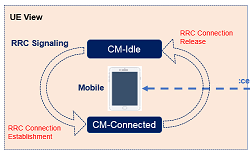CM-Idle and CM-Connected
When a Mobile wants to communicate with 5G core network, as it first time switched-on or because it was in idle state for some time and network removed the resources to transfer data temporarily, it needs to establish a connection to the Access Management Function (AMF). This is known as Connection Management.
Connection Management (CM) is used to establish and release the control plane signaling connection between UE and AMF.
Characteristics
- Connection Management depicts UE status with respect to its signalling with AMF 5G Core Node
- Connection Management is used to transfer NAS signalling messages
- Signalling Connection between UE and AMF is based on N1 logical interface and it is combination of following
- RRC signalling between UE and gNB
- N2-AP signalling between gNB and AMF
- 3GPP has defined two Connection Management State w.r.t. UE and AMF
- Connection Management -Idle [CM-Idle]
- Connection Management- Connected [CM-Connected]
- CM-Idle and CM-Connected states are maintained at NAS layer at both UE and AMF
Connection Management States Transitions
- CM-Idle define a state when Mobile does not have signalling with Core Node (AMF) e.g. RRC Idle, When UE is in CM-Idle and moving across different cells controlled by mobility based on cell reselelction.
- CM-Connected means UE has signalling connection with AMF e.g. RRC-Connected and RRC-Inactive
UE initiated State Transition
UE state moves into CM-Connected once an RRC connection has been established and within AMF UE state moves in CM-Connected once it received N2 context established. It can be performed using Registration Request and Service Request.
- When UE is powered on first time, it select best gNB based on cell selection procedure and sends Registration Request to initiates the RRC connect setup signalling toward gNB, and N2 Signaling to AMF. Registration Request triggers the transition from CM-Idle to CM-Connected.
- When UE is in CM-Idle and it has to send uplink data, UE triggers Service Request NAS message to AMF and changes CM-Idle state to CM-Connected
Network initiated State Transition
When there is downlink data to transfer toward a CM-Idle UE, network has to initiate state transition procedure using Paging message. The paging message trigger UE to establish RRC connection and send Service Request NAS message to AMF. Service Request triggers N2 signaling connection which moves the UE to CM-Connected.
UE can move from CM-Connected to CM-Idle when its signaling connection is released or when its signaling connection fails.
Reference:
- 3GPP TS 23.501 5G; System Architecture for the 5G System
- 3GPP TS 23.502 5G; Procedures for the 5G System
Related Posts:

